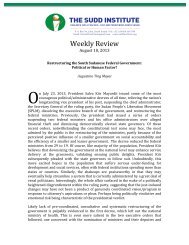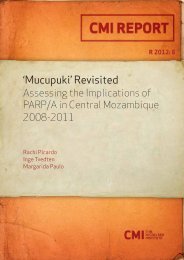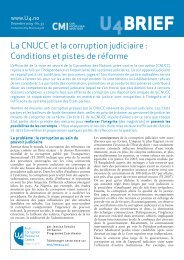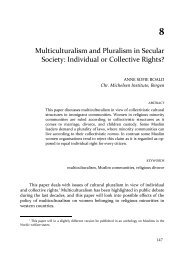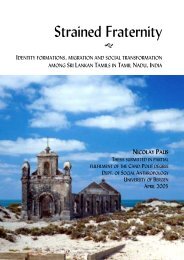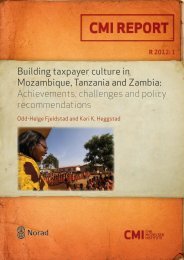Peacebuilding: Lessons for Afghanistan? - CMI
Peacebuilding: Lessons for Afghanistan? - CMI
Peacebuilding: Lessons for Afghanistan? - CMI
Create successful ePaper yourself
Turn your PDF publications into a flip-book with our unique Google optimized e-Paper software.
• there is no obvious country model <strong>for</strong> peacebuilding in post-Taliban <strong>Afghanistan</strong><br />
• the effectiveness of particular strategies varies from one country context to<br />
another<br />
• the lack of a tried-and-tested blueprint justifies innovation, risk-taking and<br />
flexibility in <strong>for</strong>mulating strategies <strong>for</strong> peacebuilding<br />
At present, the international community is simultaneously waging war and building<br />
peace in <strong>Afghanistan</strong>. The only comparable case from collective peacebuilding<br />
missions in the 1990s is Somalia (1993). That experience, as well as the logic of<br />
conflict resolution, suggests that war-related activities will undermine ef<strong>for</strong>ts to build<br />
peace.<br />
In the absence of good blueprints or obvious models, the report has adopted a macroperspective<br />
designed to provide general insight from the history of peacebuilding<br />
since the early 1990s. The review helps to answer some central questions regarding<br />
peacebuilding strategies <strong>for</strong> <strong>Afghanistan</strong> at present:<br />
1. Is the structure and mandate of the mission being prepared <strong>for</strong> <strong>Afghanistan</strong> in early<br />
2002 appropriate<br />
A large international presence <strong>for</strong> peacebuilding purposes can severely distort the<br />
economy and politics of the country in question. In poor and divided countries the<br />
effect is magnified. Large missions with ambitious agendas typically have a magnetlike<br />
effect on local politics as the various factions compete <strong>for</strong> <strong>for</strong>eign support. The<br />
economy typically develops in a dual and unsustainable fashion. The dynamic has<br />
been repeatedly observed (Somalia, Cambodia, Kosovo, East Timor). To dampen the<br />
distortion effect, a low-visibility, limited presence and a long-term perspective are<br />
essential.<br />
The modest UN mission planned <strong>for</strong> <strong>Afghanistan</strong> there<strong>for</strong>e suggests the UN is doing<br />
the right thing, but not <strong>for</strong> the right reasons. The decision is not primarily a result of<br />
institutionalised learning about the appropriate size and scope of peacebuilding<br />
missions, but reflects security considerations and the continued military campaign.<br />
The general lesson there<strong>for</strong>e has to be reiterated in the UN and to other actors.<br />
2. What are the criteria <strong>for</strong> success in peacebuilding and what are realistic<br />
expectations<br />
“<strong>Peacebuilding</strong>” is usually understood as a transitional activity designed to prevent the<br />
recurrence of past violent conflict and to lay the foundation <strong>for</strong> (re)building political,<br />
economic and social systems that in the longer run will prevent new wars. To assess<br />
what works there<strong>for</strong>e involves several criteria. A minimal test is that past violence<br />
does not recur. A more ambitious threshold is that democratic processes are seen to<br />
take hold, that economic recovery financed by donors gives way to self-sustained<br />
growth, that divided societies start to deal collectively with memories of the past as<br />
well as visions <strong>for</strong> the future, and that a state of law emerges.<br />
xii



